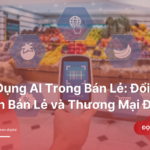Generative AI applications are shaking up industries like never before, transforming the way businesses work, create, and grow. Imagine AI that not only assists but actually generates ideas, designs, and solutions—all in real time.
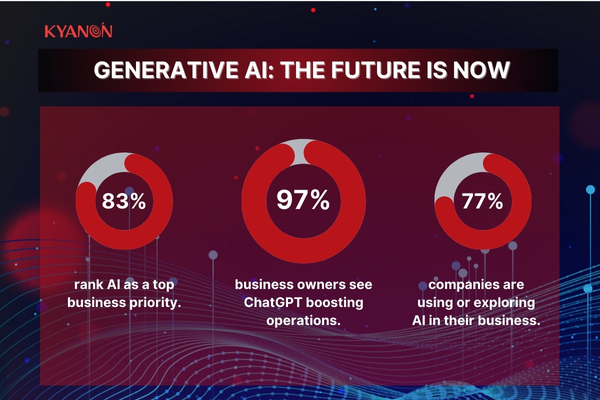
From crafting personalized healthcare plans to writing scripts for the next big hit, generative AI is everywhere, and it’s not just a trend; it’s the future. Research shows that 77% of companies are either using or exploring AI in their businesses, and 83% say it’s a top priority in their business plans. Whether you’re looking to fine-tune your marketing, accelerate product design, or spark creativity in your content, AI is ready to help you “think big” and “do bigger.”
As AI continues to make waves, over half of business owners are already leveraging AI for cybersecurity and fraud management, while 64% believe AI will improve customer relationships. Businesses are even turning to AI-powered platforms like ChatGPT, with 97% of business owners seeing it as a tool to boost their operations.
In this blog, we’ll explore 10 ways generative AI applications are taking industries by storm, showing you how businesses like yours can unlock new opportunities and reap the rewards. AI market size is expected to grow by 120% year-over-year, and the global AI market is projected to grow by 33% in 2024. Let’s dive into the world of generative AI applications – where innovation meets profit and your business gets a front-row seat to the future!
1. Generative AI in Healthcare
Generative AI applications are transforming healthcare like never before, solving big challenges while unlocking exciting opportunities.

From customizing treatments to predicting illnesses early, these AI-powered tools are helping doctors work smarter, improving patient care, and making healthcare faster and more efficient. For businesses, this means lower costs, happier patients, and the chance to lead in a rapidly advancing industry.
Example 1: Personalized Medicine
Personalized medicine is one of the most exciting breakthroughs in healthcare, powered by generative AI applications. By analyzing vast amounts of data—like electronic health records, genetic information, and patient histories—generative AI tailors treatment plans specifically for each person.
For example, Tempus, an AI-driven platform, identifies the best therapies for cancer patients by analyzing genetic mutations and previous treatment outcomes. In practice, Tempus has transformed cancer care by enabling faster and more accurate decisions, improving patient results significantly.
Generative AI also goes a step further. It can predict how a patient’s body will respond to a drug before treatment even begins. This not only saves time but also reduces potential risks.
With 80% of healthcare leaders believing AI will advance precision medicine, generative AI is rapidly becoming a key player in modern healthcare. Businesses in healthcare, from hospitals to insurance providers, can harness this cutting-edge technology to enhance patient care, reduce costs, and stay ahead of industry trends.
Example 2: Disease Diagnosis
Generative AI is redefining disease diagnosis by combining speed and accuracy, allowing for earlier detection and better treatment outcomes. By processing vast amounts of data such as patient medical histories, imaging scans, and genetic information tools uncover patterns that even experts might miss.
For instance, Viz.ai leverages AI to identify strokes in CT scans within minutes, cutting diagnosis time dramatically and potentially saving lives. Similarly, in oncology, AI helps pinpoint rare cancers by analyzing subtle irregularities in imaging and genetic data, guiding doctors toward precise diagnoses.
AI’s predictive power doesn’t stop there. It estimates disease progression, giving healthcare professionals the ability to tailor treatment plans proactively. For example, IBM Watson Health applies AI to analyze tumor profiles, identifying personalized therapies that align with a patient’s unique genetic makeup.
Businesses incorporating AI-powered diagnostics can expect reduced costs, improved accuracy, and faster workflows. As healthcare evolves, these innovations mark a pivotal step in enhancing patient outcomes while optimizing operations.
2. Generative AI in Marketing
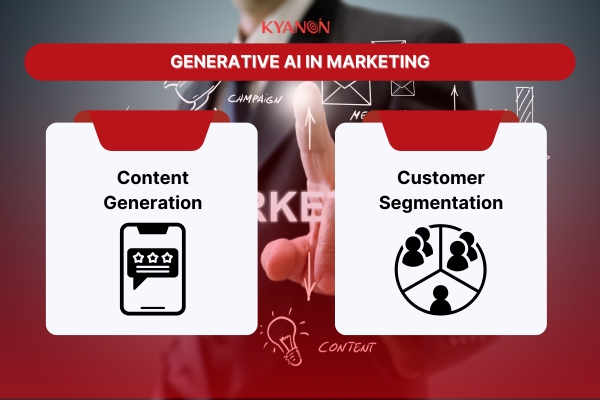
Example 3: Content Generation
Generative AI is rewriting the rules of content creation—literally. From whipping up witty social media captions to drafting blog posts that speak your brand’s voice, AI tools like Jasper and Copy.ai are the ultimate creative sidekicks.
Think of them as your marketing chefs, blending audience insights, keyword sprinkles, and tone-of-voice zest to cook up content that’s not just good—it’s finger-scrolling good.
Imagine this: you want to launch an email campaign to re-engage sleepy customers. Instead of burning midnight oil, AI analyzes customer data, predicts their preferences, and serves up irresistible personalized emails. The result? Click-through rates that soar higher than your morning coffee fix.
But AI doesn’t stop there. It’s the marathon runner of marketing, scaling content production without breaking a sweat. Whether you’re chasing trends or running seasonal campaigns, generative AI ensures your brand never skips a beat. It’s like having a 24/7 content factory-creative, consistent, and on-point.
Example 4: Customer Segmentation
Generative AI is reshaping customer segmentation by analyzing data to build precise customer profiles. It helps businesses target the right audiences with personalized marketing strategies, enhancing engagement and boosting loyalty.
By understanding behavior, preferences, and demographics, AI creates stronger connections and drives more conversions
Benefits of AI-driven customer segmentation:
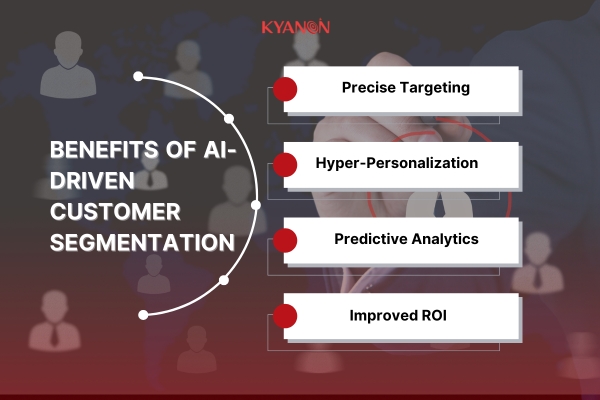
- Precise Targeting: AI analyzes customer behaviors, demographics, and preferences, dividing them into distinct segments.
- Hyper-Personalization: Tailor marketing messages to each group for stronger engagement and better customer experience.
- Predictive Analytics: Tools like HubSpot use AI to predict which segments are most likely to convert.
- Improved ROI: Focus efforts on high-value audiences, increasing sales and customer loyalty.
With AI, businesses can be smarter with their marketing, building stronger relationships while improving their bottom line.
3. Generative AI in Finance
With generative AI, the finance world is becoming more agile, empowering businesses to make faster, more accurate decisions based on real-time data.
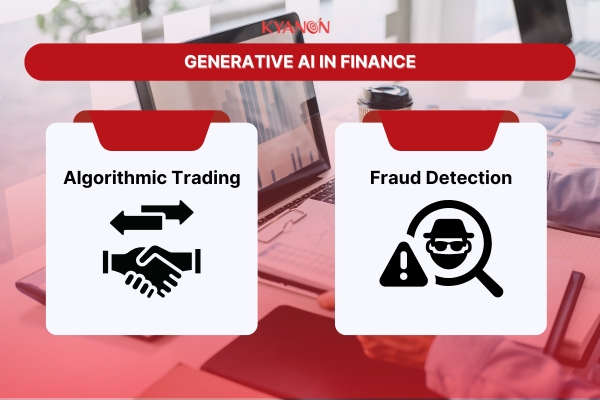
Example 5: Algorithmic Trading
Generative AI is changing the game for algorithmic trading by instantly analyzing mountains of market data and spotting trends in real time. With AI, traders can stay ahead of the curve, predicting price shifts and adjusting portfolios on the fly.
Imagine AI-powered algorithms at work, helping firms adjust their strategies based on fresh data, and maximizing profits while minimizing risks. It’s like having a crystal ball for the market—smart, quick, and always ready to make the most profitable moves. With AI, traders are always one step ahead.
Example 6: Fraud Detection
Generative AI is transforming fraud detection by monitoring transactions in real time, using advanced algorithms to spot patterns and identify anomalies. For example, if a customer’s credit card is used for an unusual high-volume transaction or in a different location than usual, AI systems can flag it as suspicious. The more transactions AI analyzes, the smarter it becomes at detecting fraud.
This proactive approach not only helps prevent financial losses but also reduces false positives, making the detection process more efficient and reliable. For businesses, this means less risk, fewer chargebacks, and a more secure environment for customers.
4. Generative AI in Manufacturing
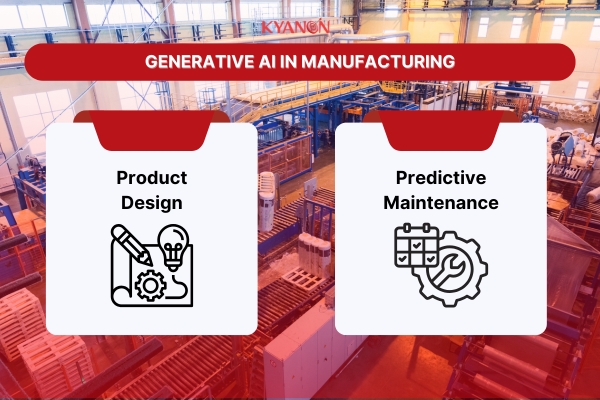
Example 7: Product Design
Generative AI is helping manufacturers break new ground in product design. By analyzing vast datasets of existing products, materials, and trends, AI can create innovative designs and prototypes in a fraction of the time it would traditionally take.
For instance, AI tools can suggest adjustments to improve product functionality or design aesthetics based on real-time market feedback, accelerating time-to-market. This allows businesses to stay competitive by quickly launching products that meet evolving customer needs while minimizing the trial-and-error phase of design.
Example 8: Predictive Maintenance
Predictive maintenance powered by Generative AI is helping manufacturers reduce downtime and cut maintenance costs. By continuously analyzing sensor data from machines, AI can predict when equipment is likely to fail and alert teams ahead of time. This enables businesses to schedule repairs proactively, avoiding costly breakdowns and production delays.
For example, AI can detect subtle patterns in machine performance, such as slight vibrations or temperature shifts, that humans might miss, ensuring operations run smoothly.
With AI’s ability to fine-tune maintenance schedules, businesses enjoy increased productivity and longer equipment lifespans, all while saving on unexpected repair expenses.
5. Generative AI in Creative Industries
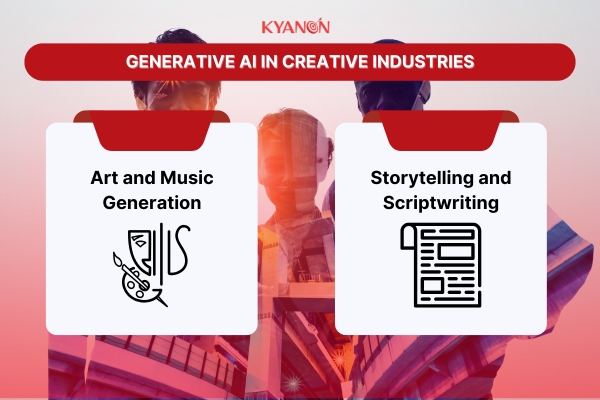
Example 9: Art and Music Generation
Generative AI is transforming the creative process in art and music. AI tools like DALL·E and Jukedeck can generate unique artworks and compositions from scratch, allowing artists and musicians to explore new possibilities without starting from a blank canvas.
This technology analyzes patterns in existing art and music to create fresh, imaginative works that resonate with audiences. Artists and brands are increasingly using AI to enhance their creative workflow, allowing them to focus on refining ideas while AI handles repetitive tasks.
This collaboration speeds up the creative process and inspires new ideas, offering limitless potential for innovation.
Example 10: Storytelling and Scriptwriting
Generative AI is also changing how stories are told and scripts are written. By analyzing vast amounts of existing literature, screenplays, and media trends, AI tools can assist writers in crafting compelling narratives, character dialogues, and plot twists.
For example, AI can suggest alternative plotlines based on the themes and emotions the writer wants to convey, or even generate entire scripts in a specific genre. This enhances the creative process by offering fresh perspectives, speeding up content creation, and ensuring consistency.
Writers and filmmakers are adopting AI to streamline their creative workflows, improve productivity, and stay ahead of trends.
6. Benefits of Generative AI Across Industries
Generative AI is rapidly reshaping how businesses operate, bringing powerful benefits that drive efficiency, innovation, and cost-effectiveness. Here are key ways AI is transforming industries:
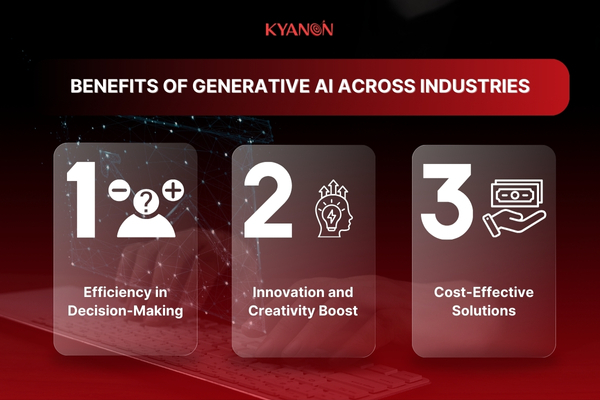
1. Efficiency in Decision-Making
Generative AI excels in processing vast amounts of data and extracting valuable insights in real time. This allows businesses to make informed decisions faster, improving operational efficiency.
Example: In the finance industry, AI-driven predictive analytics help investment firms analyze market trends and adjust their portfolios quickly. This results in smarter trading decisions and more agile financial strategies, reducing the risk of missed opportunities.
Studies show that companies using AI for decision-making see a 40% reduction in time spent on data analysis, enabling quicker responses to market changes.
2. Innovation and Creativity Boost
Generative AI fosters creativity, allowing businesses to explore new ideas, designs, and products more efficiently. Whether in product development, marketing, or customer engagement, AI sparks innovation that leads to a competitive edge.
Example: In marketing, AI-powered tools help create personalized campaigns by analyzing customer data and behavior. Companies like Netflix use AI to predict user preferences and suggest tailored content, increasing engagement and customer retention
3. Cost-Effective Solutions
AI reduces operational costs by automating repetitive tasks, streamlining processes, and enhancing productivity. This allows businesses to achieve more with fewer resources, boosting profitability.
Example: In manufacturing, AI-driven systems predict maintenance needs, preventing costly equipment breakdowns. Companies like General Electric use AI to reduce unplanned downtime by 30%, saving millions in repair and lost production costs.
7. Challenges and Considerations
Generative AI offers great potential, but it also comes with challenges that businesses must address to ensure its responsible and effective use.
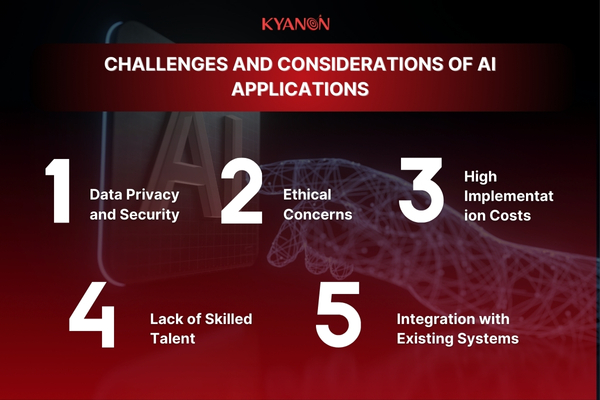
1. Data Privacy and Security
AI relies on large datasets, often containing sensitive information, which raises privacy and security concerns. Unauthorized access to customer data can lead to breaches and damage trust.
Tip: Ensure strong encryption, comply with regulations like GDPR, and anonymize data used in training AI models to protect privacy and minimize risks.
2. Ethical Concerns
Generative AI can create biased outputs if trained on unrepresentative data. It also has the potential for misuse, such as creating deepfakes or spreading misinformation.
Tip: Businesses should prioritize ethical AI practices by diversifying training data and implementing transparency in AI-generated content. Regular audits can help identify and mitigate bias.
3. High Implementation Costs
The initial setup for generative AI systems can be expensive, requiring specialized hardware, software, and expertise. Smaller businesses may struggle with these upfront costs.
Tip: Start with smaller-scale AI solutions or cloud-based services that offer scalable pricing. This allows businesses to gradually integrate AI while managing costs.
4. Lack of Skilled Talent
Implementing and maintaining AI requires skilled professionals, such as data scientists and AI specialists. The shortage of qualified talent can make it difficult for businesses to harness AI’s full potential.
Tip: Partner with AI-focused agencies, invest in upskilling current employees, or leverage user-friendly AI platforms that don’t require in-depth expertise to use.
5. Integration with Existing Systems
Integrating generative AI with legacy systems can be complex, leading to disruptions in operations if not handled properly.
Tip: Choose AI tools with integration capabilities that work seamlessly with existing infrastructure. Plan for a phased integration to avoid disrupting business operations.
The Big Picture
Generative AI is not just a passing trend; it’s a tool businesses can use to drive smarter decisions, innovate faster, and reduce costs. As AI continues to evolve, it will become even more integral to business strategies, helping companies stay ahead of the curve in an increasingly competitive market.
From predictive analytics to personalized marketing, its applications are vast and transformative. As AI continues to evolve, those who embrace it will gain the competitive edge needed to thrive.
Ready to harness the power of AI? Kyanon Digital can guide you in unlocking its full potential. Contact Kyanon Digital today to discover how we can support your data governance journey and drive your business forward.

